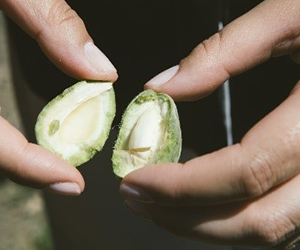In this final installment of our four-part “Optimal Yield Series,” Almond Board of California’s (ABC) Sebastian Saa discusses the key elements for maximizing kernel weight — or, as he puts it, filling up the balloon.
“The hull is like a balloon,” said Saa, associate director of Agricultural Research at ABC. “You want large balloons on your tree and then the process of filling up those balloons with kernels begins.”
Growers are starting to see those hull balloons reach full size, which generally occurs by the first full week of May. Management decisions related to water and nutrients from now until July will largely determine the success — and size — of kernel development inside the hull. Saa notes that growers have access to ABC tools and resources, such as the Nitrogen Calculator and Almond Irrigation Improvement Continuum, to help quantify and meet tree nutrient and evapotranspiration demands.
“Inflating the balloon is relatively cheap for the tree, but essential. However, it’s an expensive proposition, as trees require a lot of energy, i.e. carbohydrates, to develop good quality kernels,” Saa said.
Through photosynthesis, sunlight is harvested to produce carbohydrates, which provides energy to grow the kernel. Referencing Dr. Zwieniecki’s work at UC Davis, Saa likens carbohydrates to currency. The tree has to buy the food necessary to fill the hull balloon.
So how do growers ensure their trees will have enough carbohydrate dollars during the summer months to feed kernel growth?
“Since carbohydrates are produced by the leaves intercepting light, we want to have a canopy that covers 80% of the orchard floor in midsummer. We have a study that shows that about 80% canopy coverage in the summer is needed to maximize carbohydrate production, so good canopy cover and healthy leaves are essential,” Saa said.
He also notes that ABC is currently funding a study on carbohydrates to gain further insight into the importance, balance and timing of this critical food source and its relationship to kernel development. When complete, this study will provide growers with more scientifically vetted information to help them make management decisions.
As with most aspects of farming, present-day success relies on good decision making in the past. Reaching the desired 80% canopy size in midsummer depends on management decisions made during the spring following petal fall and leading up to early fruit growth. As Saa noted in part three of our series, all aspects of the tree are growing during this period — the roots, leaves and fruit — and each part wants to come out on top; they are all competing for resources. Satisfying tree nutrient and water demand, therefore, not only increases the percentage of fruit set, it also leads to the growth of healthy and abundant leaves, which will ultimately harvest sunlight to feed kernel growth during the summer.
“It’s all management that defines the potential for the tree to capture water, light and nutrients. The final kernel will be the direct reflection of those three factors,” Saa said.
Through this “Optimal Yield Series,” Saa hopes that growers will gain a better understanding of the factors that affect yield potential. He says that the equation for calculating yield is simple:
Yield potential = No. of flowers × % of fruit set × kernel weight
“The formula may be straight forward, but its implications are significant, especially if you can figure out how to manipulate the variables,” Saa said.
Growers can get a refresher on those variables in parts one, two and three of the series, originally published in the Almond Board of California’s In The Orchard weekly e-newsletter.
Have questions about any of the topics covered in this series? Email Saa at ssaa@almondboard.com.


